


| Pape art in #s 7 & 12 of |
 |
Two pages of Pape in First Annual Collection |
 Thanks to Warren Coolidge for providing
me with more information about Eric Pape. I've left the original
page intact below the next horizontal line, but now we have some
concrete information on Mr. Pape. Mr. Coolidge, who married Pape's
second wife after Pape's death, found my page and graciously submitted
a package of words and pictures that help round out the history
of this interesting and important American illustrator.
Thanks to Warren Coolidge for providing
me with more information about Eric Pape. I've left the original
page intact below the next horizontal line, but now we have some
concrete information on Mr. Pape. Mr. Coolidge, who married Pape's
second wife after Pape's death, found my page and graciously submitted
a package of words and pictures that help round out the history
of this interesting and important American illustrator.
Firstly, he sent a biography of Pape as published in the The Glouster Pageant around 1910. I'll paraphrase it here, but if you want to read the entire article, click on the picture of Pape at left.
Pape was quite the prolific prodigy. He studied at the San Francisco School of Design, but left for Paris in 1888, while still in his teens. He spent a couple years in Paris studying at many of the best schools. He studied under Boulanger, Lefebvre, Constant, Doucet Blanc, Delance, Laurens and Gerôme. [We can take all of this two ways: either he was a quick learner and he was going from instructor to instructor in search of knowledge; or he was unfocused and flitted from ecole to ecole. My guess is the former, as his prolific output during his early years is staggering.] Of the five years he spent in Europe, one was "on location" in northern Germany where he found and painted the subjects for his first Salon entries (1890), and two were in Egypt. Records show that he exhibited ten paintings in Cairo in 1891, four at the Paris Salon of 1892, two Egyptian pieces at the World's Columbian Exposition and eight works at the Paris Salon - both in 1893, the year he returned to America.
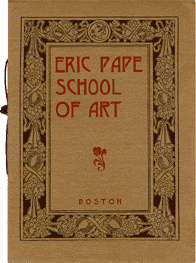 He
married Alice Monroe in 1894. (I guessed 1896 below.) In 1897
he seems to have returned to Europe where he exhibited by special
invitation at the International Kunst Austellung in Munich. That
same year he submitted sixteen (16!) pictures to the Salon at
the Champs de Mars and had all 16 accepted by the
jury. He was asked to choose eight to be displayed as there wasn't
room for all sixteen. Read the Pageant biography for more information on his prodigious output.
He
married Alice Monroe in 1894. (I guessed 1896 below.) In 1897
he seems to have returned to Europe where he exhibited by special
invitation at the International Kunst Austellung in Munich. That
same year he submitted sixteen (16!) pictures to the Salon at
the Champs de Mars and had all 16 accepted by the
jury. He was asked to choose eight to be displayed as there wasn't
room for all sixteen. Read the Pageant biography for more information on his prodigious output.
In 1898, at the ripe old age of 28, he founded the Eric Pape School of Art in Boston. N.C. Wyeth was an early pupil for a short time and even considered teaching there in 1909. I don't know how long the school lasted, nor, for that matter, does the information Mr. Coolidge sent address the Frederic/Eric question (see original page below).
Below is a sample of one of his 1904 paintings, also courtesy of Warren Coolidge. It's from a very nice signed print he sent me.
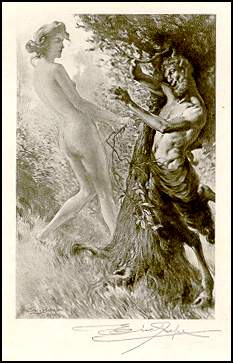
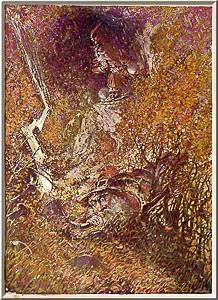 In
1906, Pape was instrumental in rescuing the U.S.S. Constitution ("Old
Ironsides") from certain destruction. In the space of three
weeks he circulated a petition to save the historic ship and the
170 foot long document with over 30,000 signatures was presented
to the Congress of the United States. It was instrumental in convincing
Congress to fund restoration.
In
1906, Pape was instrumental in rescuing the U.S.S. Constitution ("Old
Ironsides") from certain destruction. In the space of three
weeks he circulated a petition to save the historic ship and the
170 foot long document with over 30,000 signatures was presented
to the Congress of the United States. It was instrumental in convincing
Congress to fund restoration.
The list of books he illustrated is also greatly expanded due to the information Warren provided. See the Gloucester Pageant article for even more, but to those named below, we can add:
- The Life of Napoleon Bonaparte (1895)
- Hilda Stafford (1895)
- The Children of the Sun (1897)
- The Life of Mahomet (1899)
- The Great North Road (1899)
- The War of the Air (1908)
- Memoirs of Ellen Terry (1908)
 Another
great Pape illustrated book is his Notre Dame de Paris,
of 1928. I don't know how I could have omitted it the first time
around, but I want to rectify it right now. Illustrated in color
and b&w, the 'List of Illustrations' is four pages long! At
right is a sample of the line work. It was issued in a signed
and numbered deluxe edition, too. Not a common occurance in 1928!
Another
great Pape illustrated book is his Notre Dame de Paris,
of 1928. I don't know how I could have omitted it the first time
around, but I want to rectify it right now. Illustrated in color
and b&w, the 'List of Illustrations' is four pages long! At
right is a sample of the line work. It was issued in a signed
and numbered deluxe edition, too. Not a common occurance in 1928!
Thanks again to Warren Coolidge for all the data. It was fun spinning together a bunch of observations into a biography, but it's much better to present the facts.

More samples of Warren Coolidge's generosity below.
| I used this image on and off over the years as the graphic on the catalog envelope for my book business. Last month Warren sent me the original Pape art for it. What a guy! |

|
|
This next is an illustration from the Preface of Fairy Tales and Stories by Hans Christian Andersen (more below) Thanks again, Warren! |
 |
| and now the original speculative biography I wrote. |
Sooner or later I was bound to stick my neck way out on one of these pages. Here I go.
I can't find out much about Eric Pape. I've got a birth year of 1870 and he is supposed to have lived until 1938. His biography is conspicuously absent from all my reference books and my personal collection raises as many questions as it answers. So I intend to make this an exploratory page, posing questions and ideas as well as sharing with you some of Pape's excellent art.
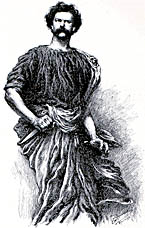 My main theory:
Eric Pape and "Frederick S.M. Pape" are the same person.
My main theory:
Eric Pape and "Frederick S.M. Pape" are the same person.
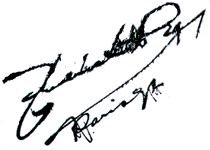 At left is an
illustration from the February 1893 issue of The Century Magazine.
It's the earliest work I've seen by "Frederick S.M. Pape"
and has the overworked look of a young artist trying to impress.
The signature is obscured in the lower right corner by a wealth
of slashing pen work, but I've tried to clean it up enough so
that we can observe the general penmanship (see right). The work
is dated "Paris '92" below the name. This signature
led me to Lois Marie Fink's excellent American Art at the Nineteenth-Century
Paris Salons.
At left is an
illustration from the February 1893 issue of The Century Magazine.
It's the earliest work I've seen by "Frederick S.M. Pape"
and has the overworked look of a young artist trying to impress.
The signature is obscured in the lower right corner by a wealth
of slashing pen work, but I've tried to clean it up enough so
that we can observe the general penmanship (see right). The work
is dated "Paris '92" below the name. This signature
led me to Lois Marie Fink's excellent American Art at the Nineteenth-Century
Paris Salons.
 This is "real-time
research" folks. Sure enough, though his name does not appear
in the book's index, Frederic Pape is among the one thousand American
artists listed in the appendix of those who submitted and exhibited
at the Paris Salon from 1890 to 1899. I've just learned that he
was born in San Francisco and was an exhibitor at the Société
Nationale des Beaux-Arts at its inception in 1890 and from 1892
through 1894. His work included paintings, sculpture and drawings.
Significantly, most of his 1894 submissions were drawings with
an Inca theme. Also in 1894, "Frederick S.M. Pape" signs
his last Century drawing on page 888 of the April issue.
This is "real-time
research" folks. Sure enough, though his name does not appear
in the book's index, Frederic Pape is among the one thousand American
artists listed in the appendix of those who submitted and exhibited
at the Paris Salon from 1890 to 1899. I've just learned that he
was born in San Francisco and was an exhibitor at the Société
Nationale des Beaux-Arts at its inception in 1890 and from 1892
through 1894. His work included paintings, sculpture and drawings.
Significantly, most of his 1894 submissions were drawings with
an Inca theme. Also in 1894, "Frederick S.M. Pape" signs
his last Century drawing on page 888 of the April issue.
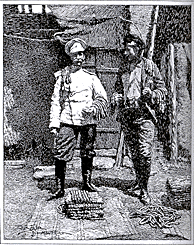
 In
August of 1894, "Eric Pape" can be found, fully developed
on page 532 of Century magazine. Along with the new name
is a new signature that seems to vary with each drawing for several
months. At right is the closest to Frederick's signature, but
it's obvious to me that though he was making every attempt to
reinvent his name, his art was giving him away. By 1923, however,
the signature had taken on many of the original elements, as seen
at the top of this page.
In
August of 1894, "Eric Pape" can be found, fully developed
on page 532 of Century magazine. Along with the new name
is a new signature that seems to vary with each drawing for several
months. At right is the closest to Frederick's signature, but
it's obvious to me that though he was making every attempt to
reinvent his name, his art was giving him away. By 1923, however,
the signature had taken on many of the original elements, as seen
at the top of this page.
From 1894 to 1898, Pape was a regular artist at The Century. He occasionally worked for other magazines of the day, including Cosmopolitan (1896) and Scribner's (1894). I've found his work at McClures in 1908, too. It's not clear that he had returned to The States to do the early work. Some of the illustrations in the 1897 poetry book, Echoes, that he illustrated were dated "96 Paris" so it's likely that he either stayed in Europe after leaving the French Acadamie. Or, he says jumping up and down with excitement, perhaps he returned for a honeymoon! A small notice in the Echoes Table of Contents informs me that "Initial Letters Designed by Alice Pape." If nothing else, I'm assuming that he was married by 1896 and that some of his magazine and book work was executed abroad.
Throughout his career, his mastery of the pen was a common thread. He was an excellent painter and his use of color was often classified as Impressionistic, but it was the ink drawings that attracted me to his art and kept me looking for more.
I called attention to the "Inca" theme of his last
Paris exhibition because his most enduring work was done for The
Fair God, Lew Wallace's novel of Cortes and his conquest of
the Aztecs and Mexico.

The two-volume 1899 edition contains upwards of 30 photogravure plates of a quality similar to the one above. There are more than twice that number of chapters, each with its own two-color head piece, initial and tail piece in pen and ink. Each was derived from an Aztec symbol or object and each was as beautiful as the sample below. This abundance of vignettes and attention to detail was to be a hallmark of Pape's book illustration.

A few images from some of my favorite books he illustrated:
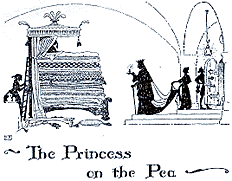 |
First is one of the dozens of small vignettes and chapter heads he did in 1921 for Fairy Tales and Stories by Hans Christian Andersen. With a color frontis and fifteen full- and double-page plates in fine line, stipple and silhouette, this is a real treasure. |

|
Just added (April 26, 2000) is the title image from "The Emperor's New Clothes" - also from the 1921 Fairy Tales and Stories by Hans Christian Andersen. Original courtesy of Warren Coolidge. Click to see full-size version. |
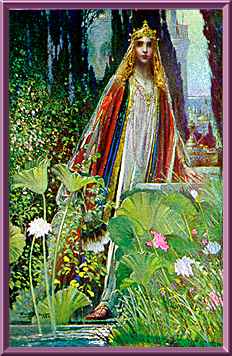
|
Second is the frontispiece from The Lotus Woman by Nathan Gallizier from 1922. Search also for The Red Confessor by the same author. Lotus Woman has four color plates and many intricate initials and half-titles. Confessor, from 1926, has only a color frontispiece, but it's gorgeous! Many of Pape's most ornately rendered pen & ink illustrations are featured in books with a single color frontispiece. Many of these are very Impressionistic and all of them are worth searching out. |
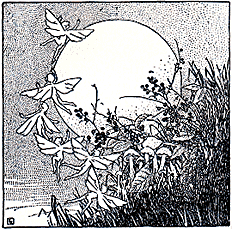
|
Also from 1922 is Shakespeare and the Heart of a Child by Gertrude Slaughter. Again, the color frontispiece is excellent but the pen & ink plates and vignettes make the book. The composition of his work reminds me of the skills of Michael Kaluta today - excellent rendering techniques made even more powerful by the strength of the design. |
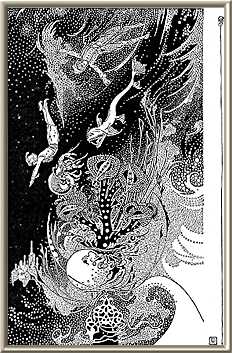 |
I think that The Arabian Nights - Tales of Wonder and Magnificence is my favorite of Pape's works. Done in 1923, the ornateness of the plates and the confidence displayed in the designs makes this one to pore over again and again. Especially wonderful are his title illustrations for each story, with hand-lettered headings and intricate and clever designs. Scattered throughout are small vignettes based on Arabian motifs, all of which are listed in the seven-page List of Illustrations. The stipple work in this book could easily have influenced Virgil Finlay! |
I've seen several other books illustrated by Pape and when I looked his name up on the Internet I found a few references to easel paintings currently for sale in galleries. And I saw an ad for a 1941 first edition of a book called Toto and the Gift, which he illustrated. Makes one wonder whether he really died in 1938 (I just acquired a copy of this in Aug. 1999, and this is a reprint of a 1926 book - mystery solved!). Other than these tidbits, the man remains a mystery to me. I really enjoy his art and hope you've developed an appreciation of it, too.
Of course, it's entirely possible that there's a biography of Pape available somewhere and all my speculation is going to turn out to be false. If so, I'll update this page with any new information that comes my way.
a. Pape is mentioned as a painter with whom N.C. Wyeth studied before he enrolled with Howard Pyle. This from the new N.C. Wyeth: A Biography which I just read. 12/27/98
b. Pape (rhymes with grape) is not to be confused with Frank Papé (pronounced 'paw pay') - they aren't even related.
 To learn more about Eric Pape, see:
To learn more about Eric Pape, see:| American Art at the Nineteenth Century Paris Salons | Lois Marie Fink, 1990 Smithsonian/Cambridge |
| The Vadeboncoeur Collection of Knowledge | Jim Vadeboncoeur, Jr. 1998 |
| The Vadeboncoeur Collection of ImageS 7, 12 B&W 1 | Jim Vadeboncoeur, Jr. 2002, 2003, 2010 JVJ Publishing |
|
Illustrations are copyright by their
respective owners. This page written, designed & © 1998 by Jim Vadeboncoeur, Jr. Updated 2000, 2011. |
